Yong Ho Ji: Making Animals Out of Tires
is a Korean artist who uses old, recycled tire scraps to make these amazing animal sculptures. ‘Mutant mythos’ is the name of the collection. Love his creative choice of medium. Yonh Ho Ji uses this material because of its flexibility and its close approximation to skin and muscles. It almost look like they are made out of liquorice. The choice of medium itself poses questions about the values of modern society, the car industry and its constant production of new tires which can be seen as a symbol of consumerism. And the title for his mutant series leads the thoughts back to Charles Darwin’s ‘origin of species’ emphasizing the need for living things to adapt in order to survive. His somewhat scary looking sculptures take the shape of sharks, wolves, spiders, deers and buffalos. He is represented by 33 Bond gallery in NYC.

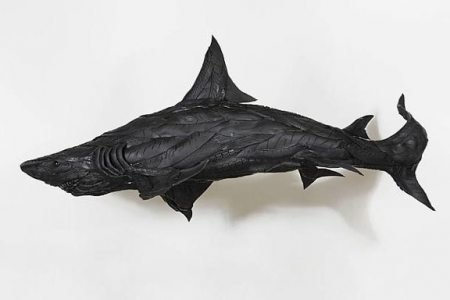
Yong Ho Ji
Tire Art: Korean artist uses tires to create animals
Via: Almost Velvet
Men Don't Have Emotions
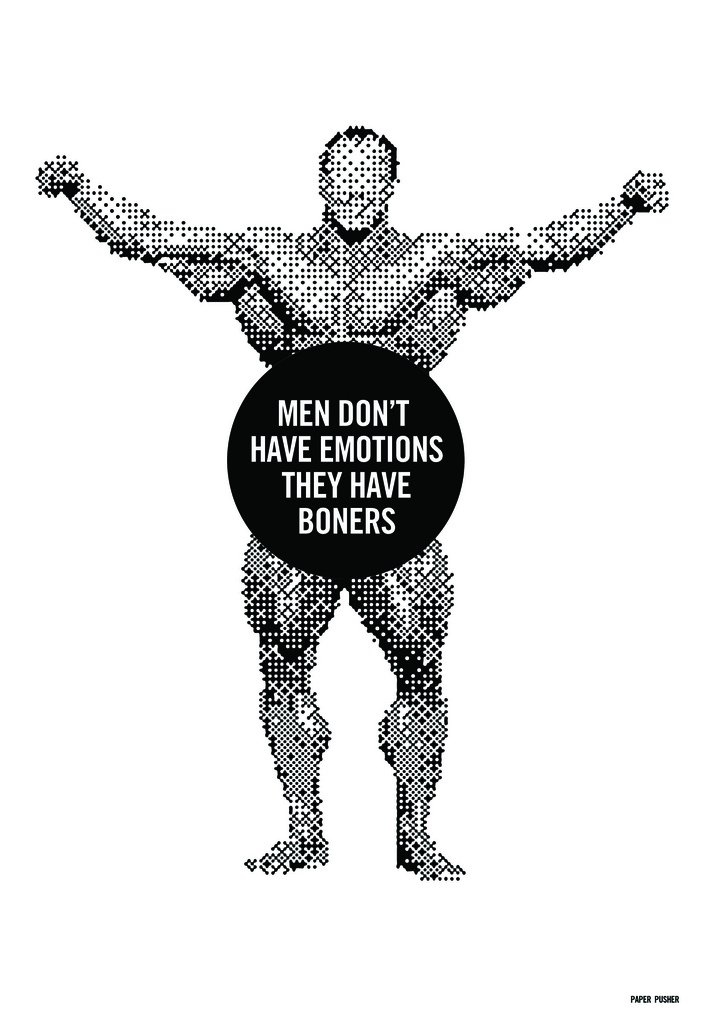
Via: JP King
I didn't get into a fight!
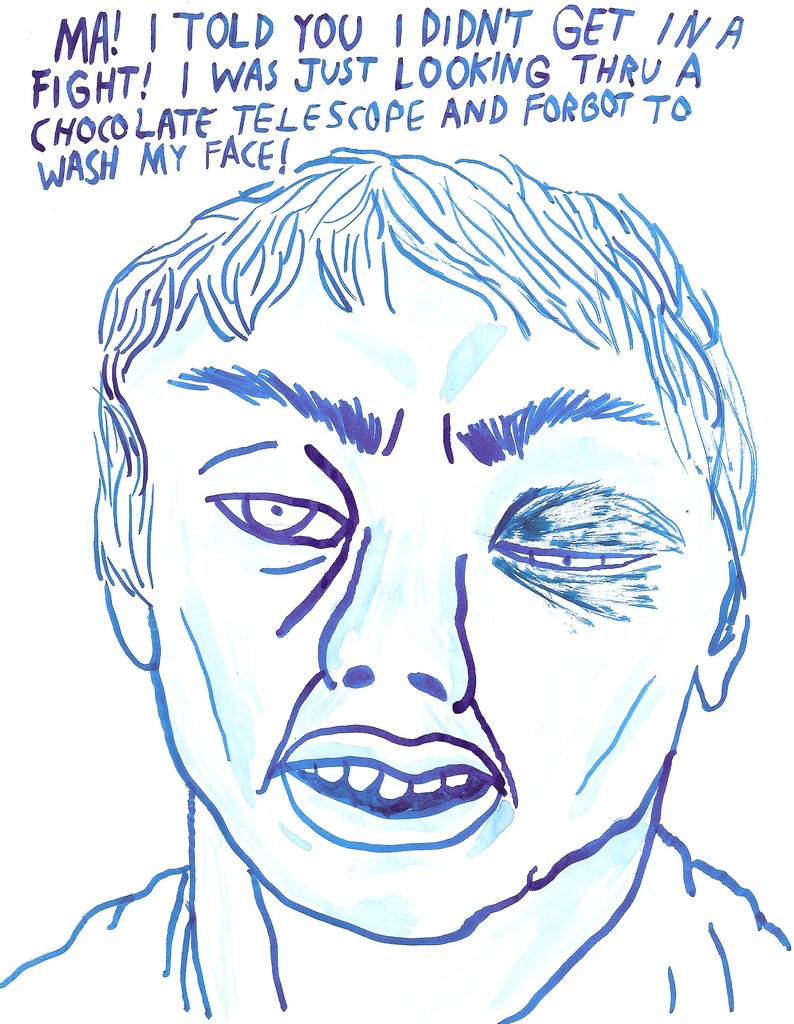
I love you to the moon and back.
Cliche and hipster? Deal with it. Via: Julia

Calvin and Hobbes Street Art
Ha, this is some street art I would like to see more of. In a world where everything is so fast paced due to the internet. A good laugh just passes us by and we don't reflect on the good old newspaper comic strips anymore. Who could ever forget Calvin and Hobbes?? Keep em' alive on the streets yo!
calvin and hobbes go extreme
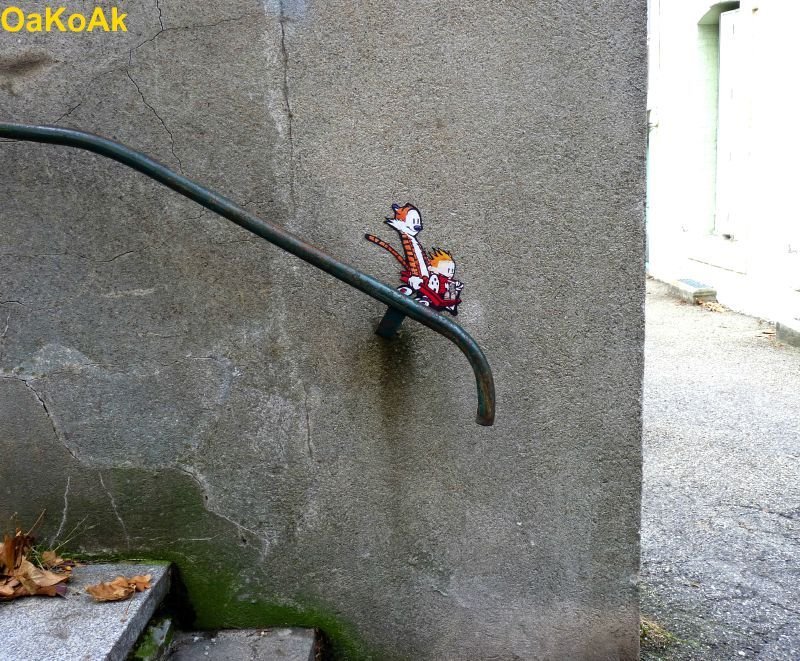
Elvira's House of Mystery
In 1986-87, DC comics published a new series, Elvira's House of Mystery. It lasted 11 issues plus a special. The series was a quasi-follow up towards the original series, with famed horror movie hostess Elvira tasked by the House with finding Cain, though she spent much of her time making fun of him, introducing horror stories similar to the original series. One issue of this series, #3, was released without Comics Code Approval and contained significant implied nudity, but subsequent editorial comments in later issues stated that the experiment in releasing an unapproved issue was not considered successful.
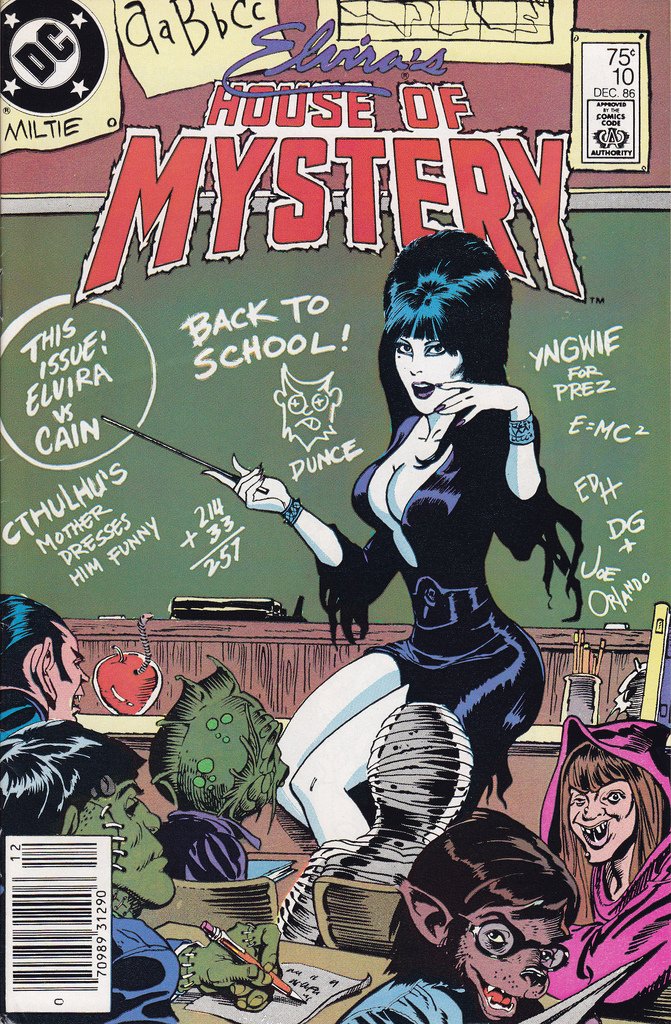
Elvira's
Comic Book
Lady Tarin
Italian Photographer graduated from the Fine Arts Academy of Bologna, currently lives in Milano.






Lady Tarin has worked with different brands and magazines including:
| GQ | Dossier |
| PIG | Novembre |
| Dust | Sang Bleu |
| Lierac | I love fake |
| Vision | Le Dictateur - No Soul for Sale - Tate Modern |
LADY
TARIN
Lady Tarin's photos are striking. Her subject matter is wonderful and I love looking at it.
Source: Lady Tarin
Gay Marriage - Elmgreen & Dragset
ELMGREEN & DRAGSET

"Gay Marriage" 2011
Porcelain urinals, taps, stainless steel tubing / Pissotières en porcelaine, robinets, tuyauterie d'acier inoxydable
43 1/4 x 17 x 48 1/2 inches
Via: Perrotin
Han Solo of Star Wars as Bob Ross
Bob Solo

Han Solo as Bob Ross. Painting beauty in a galaxy far, far away.
Witch Projection
Body Illustration by Pau Bonet
Pau Bonet is a Spanish illustrator and designer living in Barcelona. Bonet works as a freelance and collaborator for magazines, websites and advertisement. His style is crude and almost has an outsider art vibe mixed with humor and he usually works in black & white. He also works on photography and skateboard imagery.


PAU BONET
Via: VC
July 26, 7.17pm
Self-explanatory.
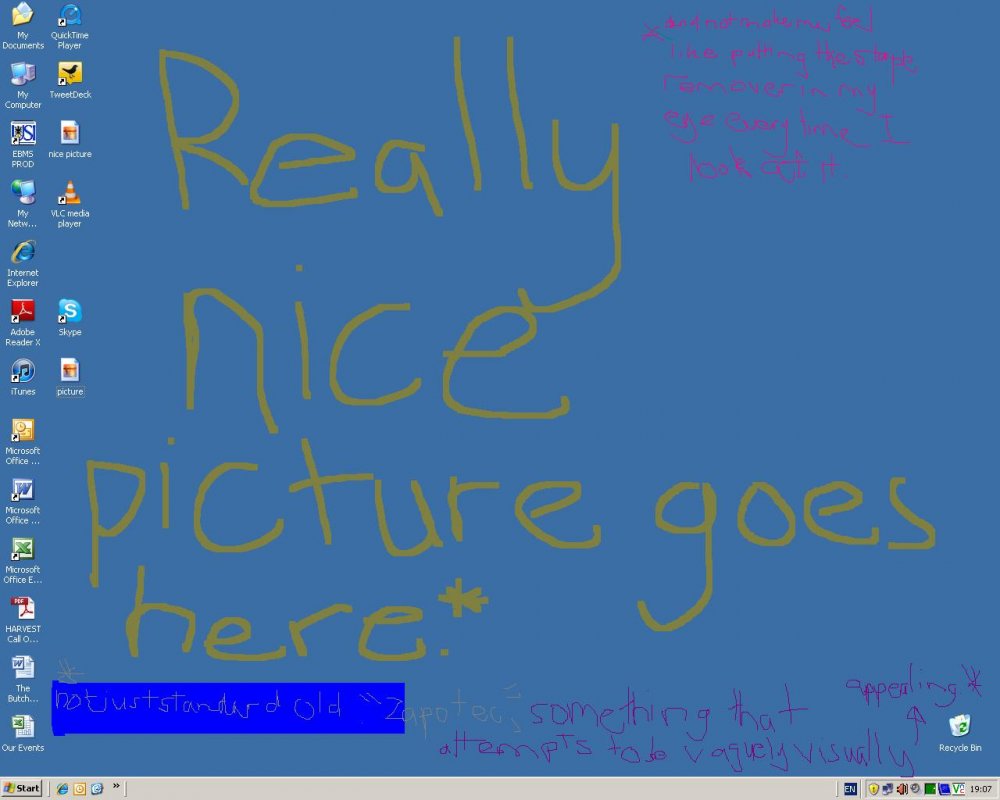
NET 205 Abalium
What are the fundamental economic basis of Internet Commerce?

What is the fundamental economic basis of Internet commerce?
- A report by Abalium with reference to major internet business Steam.
Introduction
Internet Business Model
About Steam
Value Stream -
Virtual Communities
Virtual communities are groups that come together based on a common interest. Steam’s virtual community is made up of all the users of the steam platform. Not only does it allow for users to communicate and play games with each other it also allows a platform for steam to advertise new games.
Dramatic Reduction in transactions costs
As business switch to online selling, the costs of selling the actual product reduce, which can add to the business value. Steam no longer needs to stock its games in shops to sell them as it is more convenient for a lot of its users to purchase the game online.
According to Osterwalder and Pigneur (2002) there is an understanding that “a business model is the conceptual and architectural implementation of a business strategy and as the foundation for the implementation of business processes”. With Internet Commerce only really coming to fruition in the late 1990s, there has not being a definite model used for internet businesses. There have been numerous reports based on creating business models for the e-commerce world. Mahadevan (2000) believes that the business model can be broken down into three streams – Value, Revenue and Logistics. There are many contribution facets of these streams that apply to the case study of Steam. Steam is a Business to Consumer based company that provides a product and service to its consumers. These are the main contributing elements to each stream, which relate to Steam.
Double click to add text
When you double click this text box you can change the text, style, color and fonts.
Revenue Stream –
Increased margins over offline businesses
A business that is using the online market to sell their products has a higher market share, than those businesses that are offline, which then in turn increases their margins.
Logistics Stream –
Disintermediation
Through disintermediation the supply chain that a business must go through has shrunk. Instead of Steam having to produce a hard copy of the game they can instead sell a virtual product, which reduces the supply chain costs.
The basis for internet commerce as with any other commerce is supply-and-demand. Where there is the potential to make money, there are businesses present to fill the gaps and benefit from the profits. E-Commerce business can enjoy many advantages over a traditional business; however they also face different challenges to their offline counterparts. By examining the online pc games distributor
Steam, this report will identify and discuss the foundation for internet commerce known as the Network Economy, look at the
challengesonline businesses face in terms of repeat sales and retaining a consumers attention known as the Attention
Economy,and also look at the Long Tail business model which Steam has adopted. This report will show there is a
healthy demand in the commercial market for e-Commerce sites and also show the challenges, benefits, and
disadvantages associated with supplying that demand.
Steam is a program created by the PC Gaming Distribution and Developer Company Valve. Steam was created in 2003 with the original purpose of distributing Valves own PC Games and was later adapted to distribute and sell PC Games in general. Essentially a customer of Steam must initially download software which acts as the portal from which titles can be purchased and downloaded. The purchased game is then added to the customer’s account and can then be downloaded through the applications library section. The customer is able to download and delete the game as many times as they would like the game will continue to remain within the Steam library.
Although Steam’s main function is to sell and purchase games it also offers many different integrated features. Steam contains a news section which operates similar to an RSS feed with the latest updates for Steam and also related gaming related news. It also offers a service similar to that of any social networking site. Users have their own customisable profile, choosing their profile pic, and providing various details about themselves. Users can then add other people to the friends list and leave posts on their profile page, initiate direct chat, and recommend games to others. Steam and the Steam users can also create groups by which similar games interests can be discussed and gamers can meet others to play with.
Steam and Its Long Tail
The Long tail is a concept which is based on a notion by Chris Anderson (2004). The concept springs from the greater diversity of products available through online shopping and distribution which is not economically feasible in a traditional bricks-and-mortar store. Anderson puts forward the idea that people’s interests are far more diverse than that of the traditional “hit”, “brain-dead summer blockbuster” and “manufactured pop” that the population has become accustomed to. He suggests that “Many of our assumptions about popular taste are actually artifacts of poor supply-and-demand matching.” Online stores are able to supply a much greater range of products at viable costs and meet the actual demand of consumers rather than the assumptions about popular taste. By efficiently supplying a larger range of products, businesses can “break from the traditional 80/20 rule of economics “(Judd, 2010) where 20% of products make up 80% of sales, by doing so businesses can substantially increase their profits. Looking at a traditional retail store, shelf space is essentially money. For a product to earn its keep on a shelf it must be sold a certain amount of times a year, essentially renting its position on the shelf. In an online store there is no shelf space, just storage and a web catalogue, substantially reducing overheads. This means online stores are capable of supplying the other 80% of goods that traditional stores could not afford, targeting niche markets that previously would not have been financially viable and by doing so seeing an increase in profits.

This is definitely the business model that Valve has adopted for Steam. Steam in 2009 carried 1108 games with 565 of them being free. I can only surmise that the free games are present to make steam the one-stop-shop for pc games and entice consumers to install the software in the hopes they will purchase a game later on. This leaves 543 items available for purchase. Of these games, 10% are $5 or less, 37% are between $5 - $10, 29% of games between $10 and $20, 11% at $20 - $35, 8% at $40 - $60, and the remaining 5% at $60 - $100 (Sanders, 2009).General you will find the “hit” category of games have a retail value of between $60 and $100 based on various contributing marketing factors, whereas older or less popular games generally fall below the $60 mark. Obviously Valve sees merit in embracing the longtail. With 95% of their products falling below the hit title mark, it is obvious that their products far outreach that of the traditional “hit”, or top 20% of products. In fact, if you were to compare the graph above to the Longtail graph, you would clearly see that the majority of steams products fall directly inside the longtail with only 5% within the hit market range. This shows that Valve is targeting the niche gaming markets with their products, and attempting to meet the suggested demand for variety in products.
Steam’s faith in the longtail concept is also seen in their active promotion of longtail products. Steam contains a featured product section. This can be seen by customers when the first log into the software. In this section there is an equal assortment of both the top 20% of titles and the tail or less popular 80% of products. Steam also actively promotes bundles or packages of niche market games. For example, the SEGA Mega Drive Classics Pack offers 10 games from the original Sega Megadrive which was released in the late 1980’s. This package was also a featured product on its release. This again points to Steams having the view that there is merit in the longtail concept.
In terms of Steams success, Valve does not release its sales figures so it is hard to say what percentage of their business comes from the Longtail, but
overall, steam holds a large proportion of the PC Games market online and off. According to Stardock, a rival digital distribution vendor, Steam holds roughly
70% of market share in online games distribution (Pigna,2009), and another source puts online distribution currently at 48% (Martin, 2010).
This means Steam holds 34% of the pc games market which is a good indication that the long tail concept is in some respect working for them.
From analysing Steam’s product range and their promotional techniques, it is clear that the company seriously believes in the benefits of supplying
the long tail products to consumers so much that they promote the products alongside with the traditional “hit” products. Steams success also
suggests that utilising this concept in their business model is well worth it. Taking all this into account, it all points to a demand in the market
which meets Anderson’s notion of a diversity in consumer tastes and to supply those tastes will substantially increase profits.
Network Economy
Internet commerce is now a standard format of trade for buying and selling products and services for public consumption. Markets are slowly beginning to incorporate the Internet into their operations as the convenience of online shopping in conjunction with the number of potential consumers to be reached and the low operation costs are significant incentives that cannot be ignored. The foundation of a successful e-commerce site is the accessibility to its products and services. The Internet is the network that provides this accessibility and it is where the interactions and exchanges of information take place. It is the backbone of Internet commerce and offers the connectedness to support such a large dynamic amount of transactions. Rifkin (2001, p16) describes the network as a kind of global nervous system enveloping the world. With this enormous network reaching all areas of the globe Internet commerce has been enabled to grow to support new ways of generating revenue such as lucrative advertising contracts and the trading of virtual commodities. The following aims to identify how the network has allowed Internet commerce to operate and grow. The notion of the Network economy is then addressed, linking back to the Internet’s connectedness of which is regarded as the foundations of these online exchanges. Lastly the online gaming network Steam is cited in reference to successful distribution of virtual commodities. The evidence presented in this essay supports the notion that the connectedness and accessibility the Internet provides has enabled Internet commerce to develop into what it is today.
The foundations of Internet commerce surround the worldwide accessibility to online products and services. The Internet is an enormous worldwide network that provides accessibility to communicative platforms, information and a marketplace for buying and selling products and services. As the Internet has developed over the years it is slowly being integrated into more aspects of our working and social lives. We email colleagues, we socialize via social networks, in our spare time we play games, we collaborate, we broadcast information to our families and friends and we shop online. The Internet provides an effective platform for purchasing and selling goods and services; it is accessible and visible to millions of users; it removes the physical barriers and boundaries people encounter when searching for a product or service; it is cost effective for a company who is selling products online; and it is convenient. The online gaming network Steam for example, offers a large number of new release and established games for purchase at competitive prices. At the time of writing there were 3.4 million users logged into Steam, playing games. Consumers are more inclined to purchase a game of their choice at a reasonable price within the comfort of their home. This convenience increasingly supersedes physically traveling a store to purchase a game. It is the accessibility of the Internet that has given Internet commerce the opportunity to grow and offer us convenient transactions.
Internet commerce is a part of what several theorists (Rifkin. 2001, Liebowitz. 2002, Kelly. 1997) consider as the Network Economy, of which is based on the connectivity the network provides. Key elements of the Network Economy comprise the exchange of information and experience over physical assets; technology and innovation move from modern to outdated in very short periods of time; and businesses charge an access fee or subscription as a substitute to actually selling a commodity. Rifkin (2001, p18) argues that the essential feature of commercial business in cyberspace is connectedness. This theme of connectedness is seen throughout the theoretic writings of Liebowitz (2002, p11) and Kelly (1997) in regards to the Network Economy. With the accessibility and connectedness the network provides, Internet commerce is now a well-established and convenient form of buying and selling commodities. The Network Economy is slowly beginning to emerge and the gaming network Steam shows characteristics of this new network economy.
The gaming network Steam is an example of a successful online business that sells virtual commodities. Steam offers the user a virtual product that they can’t physically hold, but instead offers them an experience. This notion is widely known as the information market; businesses exchange information for a price, which provides the consumer with an experience. In the case of Steam, the experience is that of gaming. Rifkin (2001, p17) proposed in ‘When markets give way to networks’ that in a geographically based economy, sellers and buyers exchange physical goods and services, in cyberspace, servers and clients are more likely to exchange information, knowledge and experience, and even fantasies.
This has become more apparent in present times as more businesses continue to successfully offer consumers access to a network or virtual commodities for a price, as apposed to a physical item. Other examples like the gaming network Steam that operate in this fashion are Apple’s globally successful iTunes store (http://www.apple.com/itunes/10-billion-song-countdown/), which has sold over 10 billion songs in digital format, and www.ebook.com (www.ebook.com) whom offers books for download that can be read via compatible devices. The new evolved market of selling virtual commodities is a development in Internet commerce. The Internet has facilitated this development in Internet commerce by providing accessibility to millions of users around the globe.
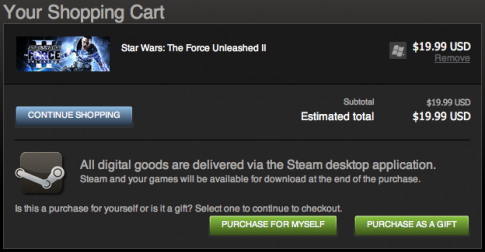
The arguments presented have proposed that the essential fundamental element of Internet commerce is the network where it resides. This was seen in the ways that Internet commerce operates, and the connectedness the Internet provides. Following this evidence was the notion of the Network Economy where the network is the essential element of which the whole online economy depends. Several aspects of the Network Economy where addressed, including the distribution of virtual commodities. This lead to the reference of the gaming network Steam, and other successful companies, whose success was linked back to the connectedness the network provides. As we can see without the network’s functionality and global reach, Internet commerce would not be as viable as it is.
Attention Economy
Attention Economy is a marketing approach that considers a persons attention as extremely rare, where they must get the persons attention to purchase a product. With millions of websites online, one of the biggest problems that internet business face is getting peoples attention. For business to drum up demand for a product they must first get the people’s attention so that they want to purchase and keep purchasing items from the business. According to Beck and Davenport (2001) a “sticky” site can lure users, hold them and get them coming back for more. They believe that relevance, community, engagement and convenience are the main tactics for achieving a “sticky” site. Steam’s website (http://store.steampowered.com) is a prime example of a “sticky” site. Its content is always relevant to gamers, with updates for games and information of game releases. It has a strong sense of community, especially with its forums and ability for players to meet and play against each other. It is also highly interactive and entertaining, with users being able to search via genre, price recommendations, and also has lots of videos and advertisements for games in the video section. Probably the biggest tactic Steam has is its convenience. The main purpose of the site is to provide a venue to sell games. The easy navigation and search function and minimal distractions of the site allow for people to easily find the game they are looking for.
Another way that Steam holds their audiences attention is by the requirement of having to use Steam as the platform to play the games purchased. Even somebody who purchases the game from an offline store must use Steam’s platform to play the game. Users can then become part of the community and create a profile. Steam then tracks users’ participation in games, their style and preferences when gaming, and what type of games they play. Steam then users this information to recommend games to users, without the user searching or really knowing to look for a new game they might be interested in. This can lead to increased sales from users purchasing these games that they would like. This is highly effective as an attention economy marketing tool, as the information is easily provided to users, with out them having to find out information on new games themselves, especially considering the backlash that has occurred since game companies have chosen to advertise in the actual game.
A selection of games that are recommended to Steam users and
available for purchase on the website. (ValveVideos 2010)
The research presented here relates back to the concept of supply and demand. The Network Economy is clearly the foundation for e-Commerce. Through the analysis of Steam this report demonstrates how Steam’s success is possible via the Network Economy, the techniques used to generate further demand via the Attention Economy, and the methods of supply and product selection via the Long Tail. Without the Internet’s wide reach across international borders, and into consumer’s homes, the demand that currently exists for an Internet based economics would not be present. The research and study of the Attention Economy clearly demonstrates the need for advertising and attention retaining of customers to generate a demand for the specific market the e-commerce site is targeting. The analysis of the Long Tail business model demonstrates the demand in the market for niche products and the financial success of supplying that demand. All these elements at their most fundamental basis are about generating, supporting, or supplying a demand.
Conclusion
Another form of advertisements that are seen on the Steam website is the trailers for games in the video section. Although these trailers aren’t produced by Steam, they are using the typical action packed and dramatic trailers that game producers are fond of to grab the users’ attention, and prompt them to purchase the game. It is all of these elements that make Steam at the fore front of its market, as the it is making sure that is getting new and existing users’ attention and holding it, there fore not only keeping existing demand but drumming up more.
A screen shot from Steam's Shopping Cart. (Steam 2011)
Group Report
In the beginning of the assignment our group formation was having troubles as several people from our group had left the unit without us knowing. Eventually with the help of Sky we formed Abalium. Since then one of our group members Sarah has since stopped communicating and we can only assume that she has left the unit. This has left us with three group members: Justin, Jen and Daniel.
The first constructive thing Abalium did was decide on a suitable web 2.0 platform where each of us could come together to communicate and collaborate. As assignment 1 had given us a broader knowledge of what was on offer, we decided the book marking service Diigo.com was suitable as it has spaces for private a-synchronous communication as well as the functionality to post or ‘bookmark’ any online media we thought could be useful to the group. E-mail has also been an important and effective communication platform throughout our studies. Early on at this stage when our group was still getting settled within Diigo, Daniel sent emails to everyone with the recommendation that the gaming network Steam is a suitable candidate for the online business to be referenced. Being a successful online business dealing with virtual commodities this was an easy choice to make for each group member.
At this stage Abalium had two channels of communication being Diigo and e-mail, and had chosen to reference the major Internet business Steam. All decision-making up to and after this point was made via e-mail. All group members exchanged their personal e-mail addresses so any communication was never delayed for great amounts of time. In the cases of deciding on a communication platform and an Internet business to reference, one group member proposed their idea to the group via e-mail, the other group members expressed their opinions and decisions were made from there. This approach to group decision-making proved effective as group members were able to express their thoughts easily and all group members were reciprocal to their opinions. Once our goals were set there were only minor modification and decisions to be made. Below is an excerpt from group e-mails sent between members that shows evidence of this.
hey guys, i've just been looking at our draft feedback and i think i should hold off writing an introduction until everyone else has written their sections. Might be a good idea for Sarah and the conclusion also. I'd like to see what everyone else writes before i type something up as i dont want to repeat the same information or contradict anyone, especially with Dan providing background info on Steam. i could write something up but i think it will just equate to more work in the long run as i would be making a lot of changes to suit what people have written.
Is this okay with everyone? I know our timeline includes editing of written work but i think in the case of the intro and conclusion our time would be better spent writing these sections between the 16th - 21st instead of amending something that probably wouldn't fit.
Justin
Hey Justin what you said makes a lot of sense as you and Sarah are basically summarizing what has been said. Its ok with me!
Daniel
Hi Justin,
That sounds good, i'm happy for the intro and conclusion to be written after the main bulk of the assignment has been written.
Thanks
Jen
As seen above minor decisions were made quite easily with group members, as they were mostly amendments to what we had already planned. Most of the group’s communication played out in this manner via e-mail.
From here all group members continued communication and each proposed a topic covered throughout the unit that can be referred to in our response to the question. We were unanimous in deciding that each person would write an essay on one of these topics and we would bring them together in a webpage for our response. With these goals in place Jen took up the task of creating a timeline and distributing a fair workload for the group seen below.
Draft Due – 7th July 9am
All Written work completed by 16th July
Start editing and checking references on 16th July
All edits of written work by 21st July
Start visual presentation on 21st July
Final Assignment Due – 28th July 9am
Each person will cover
Introduction – Justin
About Steam – Daniel
Business Model – Jennifer
Long Tail Economy - Daniel
Network Economy - Justin
Attention Economy - Jennifer
Displacement Model - Sarah
References – Everyone
Conclusion – Sarah
Group report – Everyone
The group happily accepted Jen’s planned timeline and workload without altercation. As Sarah discontinued communication whilst our written work was being completed, the assigned tasks were changed to compensate for one less member of the group. Daniel and I were quite happy for Jen to take care of the presentation side of things. Jen has chosen to use OwnZee as the presentational tool. Daniel has taken up the task of writing an introduction and conclusion for the presentation that will provide some scope into what our writings are trying to communicate. Myself, I have the task of compiling the report on behalf of the group on our communications and group processes.
References
Pigna, K. (2009, 21/11/2009). Stardock Estimates Steam has 70 Percent of Digital Market Share, from http://www.1up.com/news/stardock-estimates-steam-70-percent
Martin, J. (2010, 22/06/2010). Downloads account for 48 percent of PC game sales, from http://www.bit-tech.net/news/gaming/2010/07/22/downloads-account-for-48-percent-of-pc-game/1
Sanders, N. (2009, 23/01/2009). The Long Tail on Steam, from http://sandersn.com/blog//index.php/2009/01/23/the_long_tail_on_steam
Judd, W. (2010, 15/11/2010). The Long Tail, from http://williamjudd.com/2010/11/15/the-long-tail/
Anderson, C. (2007, 30/01/2007). The Long Tail, from http://www.longtail.com/the_long_tail/2007/01/the_beginners_g.html
Anderson, C. (2004). The Long Tail. Wired Magazine, (12.10). Retrieved from http://www.wired.com/wired/archive/12.10/tail.html
Mahadevan, B. (2000). Business Models for Internet based E-Commerce An Anatomy. Retrieved from http://www.thetawer.com/wiki/images/archive/c/ca/20090130182257!B._Business_Models_for_Internet_Based_E-Commerce.pdf
Osterwalder, A., Pigneur, Y. (2002). An e-Business Model Ontology for Modeling e-Business. Retrieved from http://74.125.155.132/scholar?q=cache:553QSPjcR7YJ:scholar.google.com/+what+is+a+business+model&hl=en&as_sdt=0,5
Kelly, K. (1997). ‘New Rules for the New Economy: Twelve Dependable Principles for Thriving in a Turbulent World’ in Wired.
Retrieved on the 11th of July 2011 from:http://www.wired.com/wired/archive/5.09/newrules_pr.html
Leibowitz, S.J. (2002). Basic economics of the internet from Re-Thinking the Network Economy: The True Forces that Drive the Digital Marketplace. New York: Amacom. (pp. 9 - 24).
Retrieved on the 11th of July 2011 from:http://edocs.library.curtin.edu.au/eres_display.cgi?url=dc60264075.pdf©right=1
Rifkin, J. (2001) ‘When markets give way to networks’, in Age of Access: new politics of hypercapitalism where all life is a paid for experience. Ch. 2, p 16-29.
Retrieved on the 11th of July 2011 from:http://edocs.library.curtin.edu.au/eres_display.cgi?url=dc60264125.pdf©right=1
Beck, J., Davenport, T. (2001) ‘The attention economy: understanding the new currency of business.’ Retrieved from ttp://books.google.com.au/books?id=FuuKd3on9psC&lpg=PA1&ots=RJYJJu01Yw&dq=attention%20economy%20internet%20commerce&lr&pg=PR4#v=onepage&q=attention%20economy%20internet%20commerce&f=false
ValveVideos (2010).Valve Developed Game Titles ( 1998 - 2009 ) Retrieved from http://youtu.be/ZdqFfwLZdVA
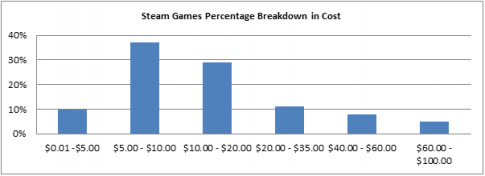
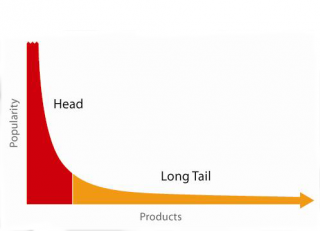
(Sanders 2009)
Ira Chernova
Superhero Waterski Show
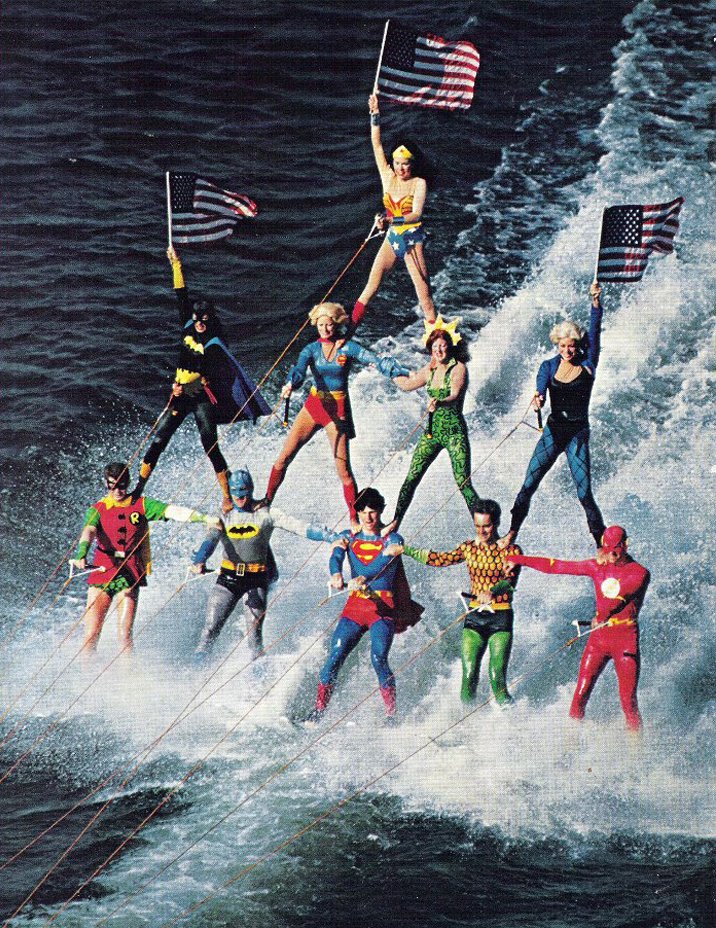
Superhero Waterski Show
Via: Dreams Like That
If I were a Zombie

Prettiest Lady you'll see all Week.


Eye for an Eye
Eye

for an
eye
Barbie Pizza Hut Party
Ain't no party like a Pizza Hut Party, cuz a Pizza Hut Party don't stop!


Permission Granted: Kent Rock Band Give a Taste of Things to Come
Intraverse
w/ Origami Dinosaur
The Forum, Tunbridge Wells, 15th July 2011
In my time going to gigs around the country I have been to a variety of different venues, established venues, stadiums, festivals, pubs and clubs. But never in my time have I arrived at a location which used to be a public toilet. Never. Until tonight that is.
The Tunbridge Wells Forum is a surprisingly spacious room, with a decent stage area as well as having a good sound. Its location on the Green makes it easy to find, which is handy when you are heading into the unknown by yourself on a Friday night. I am here to see Intraverse. This is the night of their new single launch ‘Grant me Permission’. I shall get to the music momentarily, but before the set I caught up with two members of the band, Mikey (bass) and Tim (drums) to talk about live music, touring and the expectations of the new single.
LifeArcade! (LA!): Thank you for taking the time out to join us. Let’s get started. How does it feel coming back to a local gig? Is it good to have the local support behind you, especially for a single launch?
Mikey: Well this is actually the first single launch we have done in our home town. For the previous single we didn’t really organise a specific gig to release it, but it is nice to have a good vibe about tonight. As for the local support we have a fantastic following. But it is not just that, we recently played Download and there are people here tonight who have come down from the Midlands to see us play, which is pretty incredible.
LA!: As you say, you have recently played Download Festival. What is it like playing to a crowd that you have to win over in a sense? Is there any pressure there or do you thrive in that environment?
Tim: You do thrive on it, but you also do feel a little bit of pressure because it is new people and it is also the traveling up there – it is not just down the road. But it is exciting because it is a test, as you have the music that you like and play, and you are playing to a crowd that are the judge, aren’t they? So it is whether they choose to accept it and it was good for us because they were accepting it. I think we took a bit of a risk; we were on the acoustic stage and we started our set by clicking our fingers, then bringing in the guitar as we let the song build. Some people may have found that stupid as you are at a heavy festival, but we did our thing and it went down really well. It also helps that we have some more up tempo tunes. Our acoustic stuff is quite lively as well so that helped to build through the set also.
LA!: So you were almost leading the crowd into a false sense of security with the clicking fingers?
Mikey: Yeah, the front man (Max) made a bit of a joke about it saying “I bet this is the first set you’ve seen beginning with clicks”, but they really enjoyed that.
Tim: You could look out at the crowd who were all there for 12.30 and see these heavy metal fans, and they were enjoying it.
LA!: Tonight you are in Tunbridge Wells, but what is your favourite place to play outside of Kent, and how is your response on the road?
Mikey: Personally I like playing in Brighton because of the relaxed vibe they have down there. We also enjoy playing in London. It helps that they are both relatively close to home.
Tim: I don’t want to sound big headed but we haven’t really got any bad reactions anywhere we have played. But it is difficult to say; wherever we have gone we have got good press. We just go out and play our music and hope the people enjoy it as much as we do. That’s the bottom line.
Mikey: We must be doing something right!
LA!: When you are playing festivals, what is it like from a band’s perspective compared to a smaller venue such as The Forum?
Mikey: I don’t feel the pressure of it. We have been playing for a long time now and it is just something that we do. We relish the opportunities to play the festivals, but also the smaller ones are just as good. There is a different atmosphere with the closeness, which is great. You can literally see the expressions on peoples’ faces which gives you a good buzz when you see them smiling at you and enjoying themselves. We just try to go out there and enjoy it. It’s just fortunate that people seem to take to it.
LA!: Your last single ‘Please Don’t Share Your Kisses’ reached No.4 in the iTunes chart. What are the expectations for the new single? It is a bit of a different sound from previous tracks.
Mikey: Personally I have no expectations. Obviously we hope it does well, but we are putting it out there because we feel it is the right song to put out there, and as Tim said earlier, the audience will be the judge and we will soon know if we have come up with something that they either like or they don’t.
Tim: I don’t think we actually write to a formula. We just write tracks that we enjoy, so I don’t think that you will hear another ‘Please Don’t Share Your Kisses’- esque song; I don’t think we are that sort of band. I do not think we would ever write an album that included the same formula and similar tracks throughout, so in that respect it is a risk.
Mikey: We just want to be true to ourselves. We are too creative as a band to just stick to a routine formula. In doing this we feel that we are not ‘selling out’ as it were, because we are not rigid in our approach to making music. It is a risk we have to take.
With the sound of the music pumping from within The Forum, we headed back inside where the first band of the night was underway. Origami Dinosaur are far from prehistoric with their music, with elements of funk and rock fused into an upbeat and catchy sound which gets the crowd head bopping from the off. The guitar work stands out in the same way ‘guitar’ bands such as The Strokes or Artic Monkeys make it pivotal to their noise. The air plectrum was strumming against the thigh throughout this set. The bass was also impressive and had aspects of Red Hot Chilli Peppers, The Gossip and London-based band The Skints during the songs as well as in the solos, a nice touch when some bands lose the sound of the bass in a live setting. The drums were very good and kept a very good rhythm during the set, they also did not get too overcomplicated during the faster moments, which was refreshing to see. The lead singer did his job as the front man exceptionally well. He was full of charisma and had the audience in the palm of his hand during the entire set. On a bigger stage, he could quite comfortably fill the space with his stand out swagger and strong voice. A great start to proceedings and a perfect build up into the headline act.
With the crowd replenished at the bar, Intraverse hit the stage and instantly you know this was a homecoming gig. The response from the crowd is impressive as the band kick off their set to the arrival of balloons from above. Nothing says party like falling balloons, a nice touch that sets the tone for the rest of the set. This is a celebration of the bands recent success as well as new single release, and both the crowd and the band appreciate this.
It is hard to put down a comparison to Intraverse as their sound is quite unique. The band say that their influences are, “whatever that is floating our boat at the time” and that is clear both live as well as recorded. There are hints of metal, electro and even jazz that makes this band so interesting to watch and listen to. The front man Max, despite nursing a sore throat, shows a strong and powerful voice, reaching notes that make you question any illness. His voice compliments the eclectic mix of influences well and holds it all together nicely. His stage presence is also strong, making direct contact with the crowd, bringing further intimacy to an already close gig. The guitar work during the set was wonderful to hear, bringing notions of Muse and System of a Down to the fore - a combination that I certainly cannot complain about. It sometimes felt that the music was coming from all directions and definitely helped me, and the rest of the audience, into the music. The bass was funky and drew comparisons similar to those of Origami Dinosaur, but there is also a hint of The Flecktones, a band Intraverse have said they would like to play with. The drums blended well with the rest of the music and could range from heavy, hard-hitting to calmer rhythmic beats.
The set list was strong and varied, even including a bongo led instrumental which slotted in smoothly. Funk fused with jazz coexisted with more heavy metal influenced tracks. The highlight of the night of course had to be the new single, ‘Grant me Permission’. A very catchy track which even had me singing along after one verse and chorus - or trying to at least. All their influences come into effect in this track with Muse sounding guitar working alongside heavier riffs and drums. If their last single reached No.4, there is no reason why this cannot top that feat. It was well accepted by the audience and in a live setting, felt even more powerful and atmospheric than on record. Writing catchy songs seems to come naturally to this Kent fivesome. I asked Intraverse what the future holds now the single is officially out there, their answer being: “We would hopefully like to surpass the last singles achievements. We plan on touring in the autumn and we are hopeful of a debut album being released in the spring of 2012.”
As the gig drew to a close and the encore was requested and delivered, the audience eventually dispersed and headed in their respective directions, very happy in the knowledge that they witnessed a great gig with two bands of a very high caliber. Money on a ticket to the gig and a trip to Kent was certainly money well spent.
I had one more question for the band – How do you see the current state of live music in this country? Intraverse simply answered, “It’s Thriving”.
It is hard to disagree.
With thanks to Neil Hayes of Black & White Music
Intraverse’s new single ‘Grant me Permission’ is available to download now. Check out www.intraverse.com for upcoming tour dates and information.
Words by William Evans




